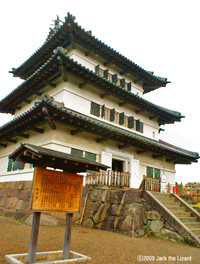
|
|
|
|
(visited on October 17, 2009)
The start was a small thought. |
|
||
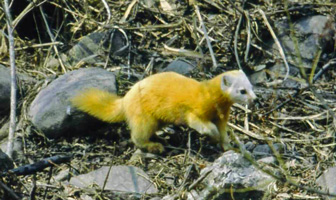 Marten
MartenPhoto provided by Mt. Iwaki Conservation Association |
Mount Iwaki is one of the top100 Famous Mountains higher than 1,500m in Japan. The mountain is the scenic symbol of Hirosaki city in Aomori prefecture. Mt. Iwaki Conservation Association was organized to protect and introduce its beautiful nature. Now the association has about 360 members not only from the local area but also from all the regions in Japan. |
||
|
"I love hiking. I have hiked Mt. Iwaki in my neighbourhood many times. I simply enjoyed climbing, but after several times of walking I noticed how the beautiful nature that Mt. Iwaki had. Plants, flowers, insects and small animals along the hiking course caught my eyes then I felt Mt. Iwaki had immense world of the nature just like the Universe", said Mr. Akio Miura, the secretary-general. The association holds nature watching tour every month. Miura explains to the participants about the animals and plants on the mountain as a natural park guide of Ministry of the Environment. The participants find so many varieties of animals and witness their lives in the wilderness during the tour. The tour makes a short visit to the place, where sulphur was extracted from the stratovolcano. Plants cannot grow there because of a particle of hydrogen sulphide leaking out from the ground. First of all the people in the tour group are surprised to see the salvage site. Then they are shocked to see dead animals there. According to Miura, animals come here to get warm. The hydrogen sulphide is so little that it's non-toxic for human, but it can be critically dangerous for small creature. It is shocking for all of the people that encountering wild animals, which people do not usually have a chance to see is actually exciting though they are already dead. "One day, we found a pair of Japanese badgers was already dead at the site. That was overwhelming for all of us to find the existence of small mammal that we did not expect to see and its death at the same time", said Miura. "Of course, we have a lot of opportunities to observe wild animals alive and that is very exciting", he smiled. |
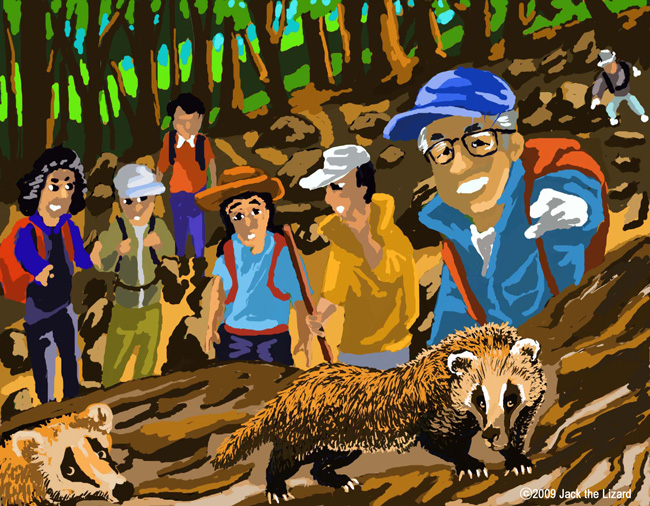
Miura explains about the animals and plants on the mountain as a natural park guide of Ministry of the Environment. |
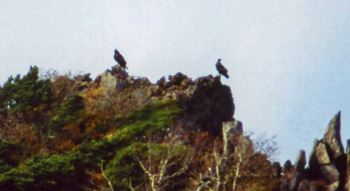 Golden Eagles
Golden EaglesPhoto provided by Mt. Iwaki Conservation Association |
Animals on Mount Iwaki
Mt. Iwaki Conservation Association researches the biology and ecology in the environment. The researchers have recognized the existence of the Golden Eagles, the Japanese crayfish (Zarigani) and the Black Woodpecker. The population of these animals have been significantly declining in all the regions of Japan.
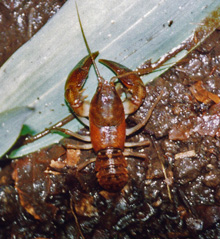 Zarigani
ZariganiPhoto provided by Mt. Iwaki Conservation Association |
Mr. Azuma Abe is the ambassador of the Association. "Zariganis are found in Hokkaido, Akita and Iwate besides here Aomori, but Aomori's zarigani is different from the others and indigenous. Because the earthworm Cirrodrilus aomorensis, which is the endangered species, lives in the body of Aomori's zarigani", said he. This tells us the fact that the animals on/around the Mt. Iwaki have adapted the local environment and created a unique ecology here. For example, the Least Weasel, M. n. namiyei Kuroda, has the unique chromosome, so it is the different subspecies from M. n. nivalis Linnaeus found in Hokkaido . He has recently realized the possibility that the Shrew, S. gracillimus, which found only in Hokkaido so far, also inhabits around the summit of the mountain. Furthermore a troop of the Japanese macaque was newly found around Mt. Iwaki Shrine in May, 2009. It seems that the there are more animals that humans has never known around Mt. Iwaki .
From research to experience
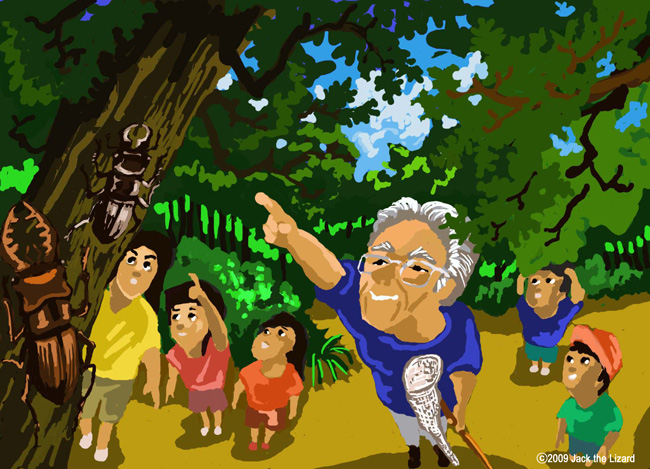 Abe explains the ecology of animals and plants on Mt. Iwaki.
Abe explains the ecology of animals and plants on Mt. Iwaki.The black Stag beetle is Ceruchus ligunarius. He research chromosomes of beetles. |
Because the environmental aspect changes depend on the altitude, we found different kinds of plants and trees on each level. When you get to know more about trees, you will be able to tell the temperature from the condition of the Japanese Beech (Fagus crenata). Abe is the researcher of insects. He shows the interesting nature of the insects on the monthly nature watching tour. "It seems that all the insects have disappeared in November, but actually many of them can be found alive underneath of the leaves on the ground. You may find more than 2,000 insects within 10 square centimetres (about 4 square inches)", said he. He sometimes finds the queen of the Asian giant hornet under bark. All of her workers finish their roles and die by the late autumn. Only the queen hibernates to survive the winter and prepares herself for the next season to form her new colony. The sting of the Asian giant hornet has highly toxic venom. However Abe said "I had never been attacked by the hornets." But He concerned that the hornet's behaviour may change because of the air pollution or the change of the environment. It is misunderstood by people as the very harmful insects, but actually it is exactly opposite, because the hornet forage the pests on the trees in the forest. Winter and early spring are very cold around here, but the great seasons to observe the wild animals because they are visible behind trees and bushes which have lost all the leaves. You may find the foot prints on snow. "It is not difficult to find the signs of bears' existence nearby. You smell them if their hibernation dens are close. You may find a Kumadana up high on trees," Abe said. Kumadana looks like a shelf or a big nest made of twigs and branches. A bear climbs a tree and eats acorns, chestnuts, oak and so on. After eating off the nuts from the branches, the bear puts them underneath of her buttocks. |
We got to keep the beauty of Mt. IwakiMt. Iwaki Conservation Association protects the ecosystem of the delicate mountain. First, the association asks the climbers and hikers not to take their pet dogs into the mountain. Pet dogs have some virus or diseases that are not found in the mountain. If wild animals get infected, the impact to the nature could be devastating. The association has also rebuilt the trail, so people can bypass where the nature is very delicate. That helps the visitors stay in the safe area to enjoy the nature of Mt. Iwaki. The association also made the base camp for Japan Red Cross Society's Mt. Iwaki Patrol Team. |
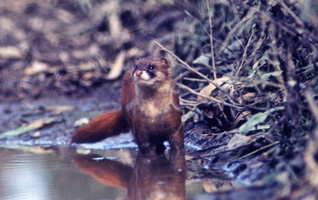 Weasel
WeaselPhoto provided by Mt. Iwaki Conservation Association |
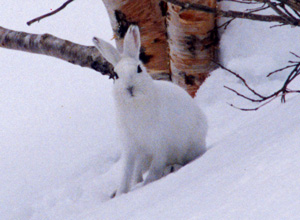 Japanese hare (L. b. angustidens)
Japanese hare (L. b. angustidens)Photo provided by Mt. Iwaki Conservation Association |
"But natural conservation is not simple as it looks", said Miura. Mt. Iwaki is very popular mountain that more than 50,000 people come to hike every year. One day, a person planted Dicentra peregrina whose nick name is the Queen of alpine plants. He thought the beautiful alpine plant could attract more visitors to Mt. Iwaki. But Dicentra peregrina was not native in this area. A member of the Association found the alien plant and decided to monitor it for a while with the government of the city of Hirosaki. They thought the environment could have already adapted the alien and re-established the new ecosystem. After a while of monitoring, the alien Dicentra peregrina was finally removed. This is very rare case in Japan. |
Not simple, not easy."We have one lost out of four. That was not too bad", said Abe. His successful conservation activities made three of the ski resort plans cancelled.
Miura said "We sometimes have to take the side against the development which helps the local economy grows. We have faced many obstacles along the way. But we have kept talking to the people about the impact on nature. Now so many people get to be familiar with how precious nature we have." Most of the local people think the new sky resort is no need here anymore. |
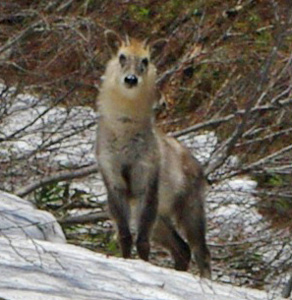 Japanese Serow
Japanese SerowPhoto provided by Mt. Iwaki Conservation Association |
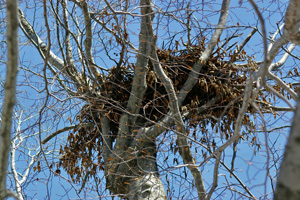 Kumadana made by an Asian Black Bear
Kumadana made by an Asian Black BearPhoto provided by Mt. Iwaki Conservation Association |
What next?There are some reports that the local corn fields are damaged by the wild Asian black bears. In some cases the apple farms are damaged by raccoon dogs. Although the population of the Asian black bear is quite small, Miura and the member of the association worry that a bear could appear in towns soon or later. Since the climate change transforms the vegetation in the mountain. The wild animals have to change their behaviour to survive. The evidences are already getting prominent. The members noticed new plants and tree that have not existed here before. Now the research is urgently needed to find out what the impact on the animals is. Naturally as the activities of the association are getting well-known, the reports from people are increasing. For instance the report on the bear which had never seen in the area came from the local people. One day a citizen found an injured Grey nightjar and called the association. The staff member relayed the news to the sanctuary centre for rehabilitation. Miura, Abe and all members definitely believe that the reports from the people to the association will help the natural conservation activities more. |
For love the mountain
|
Miura enjoys winter mountain hiking. His wife does not like him to enter the dangerous winter mountain. He still hikes because he wants to enjoy both the beauty and experiencing harsh cold weather in Mt. Iwaki. He thinks that deep cold snow reminds him of the power of nature.
|
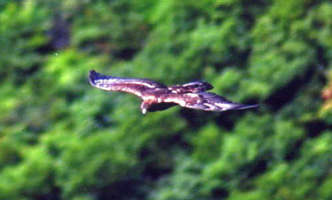 Golden Eagle
Golden EaglePhoto provided by Mt. Iwaki Conservation Association |
